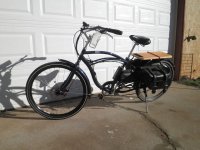beachcruiserbuild
100 µW
- Joined
- Jun 26, 2015
- Messages
- 9
Hello all, this is my first post on here as I'm currently planning my first E-bike build. I've decided to go with a mid-drive system, I've already pretty much figured out how I want to mount everything I'm just having trouble figuring out the correct placement configuration for the motor, battery, and controller. I just want to make sure that everything I order is compatible. I plan on using a Turnigy RotoMax 1.60 Brushless Outrunner Motor (http://www.hobbyking.com/hobbyking/stor ... Motor.html) with 1 or 2 Turnigy 5800mAh 8S 25C Lipo Pack (http://www.hobbyking.com/hobbyking/stor ... _Pack.html). The problem is that the motor is rated for 37V but the battery is only rated at 29.2, will this be a problem? the only problem I'm having is determining how much power I am going to use with the motor. I'm not sure if 1 5,800mAh battery will be enough, so maybe I'll just buy 2 and wire them in parallel to get a 11,600mAh battery, but again I'm not sure if I'll have enough Volts to run everyting. My next problem is the controller, I've researched a good bit and found that a sine wave controller(should)give me the smoothest and quietest ride from the motor. I have found plenty of controllers rated for 36V but only up to 1000W (the motor is rated for 2960W). I want to be able to use the full power of the motor as my goal is to be able to ride around 20 miles with a top speed around 30 mph. I cant find an appropriate controller to control that large amount of power. Could someone please give me a recommendation on what I should be using? I was told a Mamba XL2 ESC (http://www.castlecreations.com/products/mamba_xl2.html) would be good enough but I'm not really sure. As this is my first build any advice is appreciated. Thank you all


